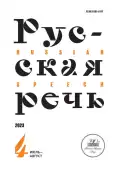Modern linguistics pays special attention to semantic areas that correlate with the basic concepts of universal significance and in many ways form a person's idea of themselves and the reality around them. In dialects, where vibrant dialectal features are gradually being lost, these basic concepts preserve the territorial characteristics of their scope and content. Based on the analysis of the semantics and compatibility of the word zemlyá (earth) and its derivatives, the article defines the scope and content of the universal concept “ZEMLYA”, characteristic of the bearers of the traditional folk culture of the Russian North. The article describes customs, beliefs and prohibitions associated with the earth or land. The earth appears in them as the mother earth, mother, mom, the earth is holy, it feeds us, it needs to be entertained, cleaned, it needs be bowed to, on holidays it cannot be touched, disturbed, it cannot be disturbed, this day the earth is a birthday girl. After harvesting, the land is motionless. A person should live on his own land, put down roots into the earth, become rooted to the earth, people need to be planted on the ground. All the nuances of meanings are covered by the idea of the maternal origin of the earth. Many customs and beliefs that make up the mythology of the earth are almost forgotten or already lost by the speakers of modern Arkhangelsk dialects. However, the language has preserved memories of them in the form of precedent texts, stable phrases that contain the folk philosophy of life and death. The analysis of the material revealed that the concept of ZEMLYA is embedded in the main semantic oppositions that form the model of the world. The opposition “bottom – top” is represented by the opposition of the earth to the sky, in the opposition “nature – agrarian culture” the earth appears as an object of processing and a source of nutrition. In the opposition “friend – foe” the earth is the place where a person was born, his own, native land, in the opposition “life – death” the earth is associated with the arrival of a person to this world and with his inevitable departure.
 7-24
7-24


 25-39
25-39


 40-50
40-50


 51-62
51-62


 63-73
63-73


 74-89
74-89


 90-101
90-101


 102-112
102-112


 113-127
113-127











